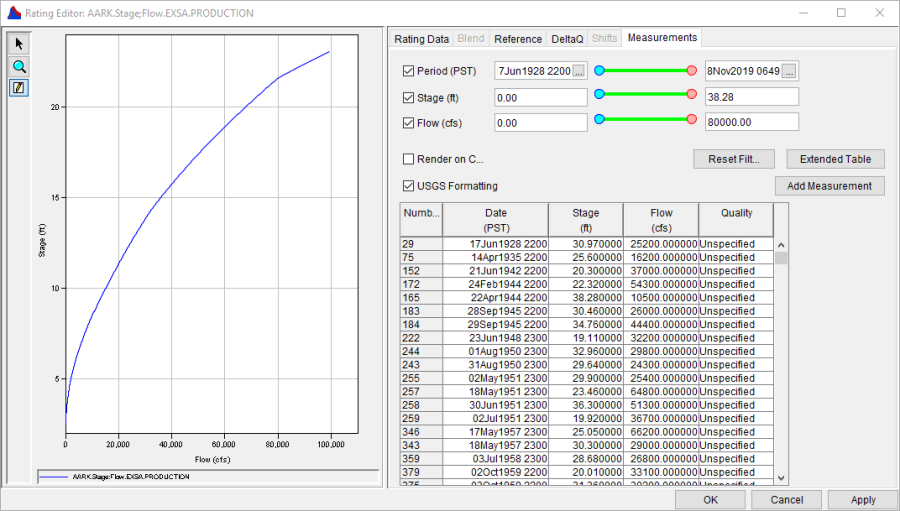Download PDF
Download page Rating Editor Tabs.
Rating Editor Tabs
The Rating Editor Window contains a set of tools for viewing and manipulating the rating curve data through the Rating Editor Tabs. There are six available rating editor tabs, and the availability of the tabs depends on the type of rating curve displayed in the Rating Plot.
The Rating Editor Tabs are:
- Rating Data – Displays the rating curve data in a tabular format and allows the selection and editing of data points (default tab).
- Blend – Allows the addition of blending flow and stage time series.
- Reference – Allows the addition of reference levels and rating curves on the plot of the rating curve and table of the rating curve data.
- DeltaQ/Expanded
- DeltaQ (stream ratings only) - Displays the stage, flow, DeltaQ (slope of the rating curve) and Delta2Q (rate of change of the slope) for a stream rating.
- Expanded - Utilizes the rating to generate an expanded table across a controlled range of values.
- Shifts – Allows the computation of shifted rating curves. This tab is only available for USGS stream ratings (which are not discussed in this appendix).
- Measurements – Allows the display and editing of all stream measurements of the rating at a given location. This tab is only available for stream ratings.
Rating Data Tab
The Rating Data tab displays the rating curve's Effective Date and the Rating Data Table. The Rating Editor also allows the viewing and editing of the Rating Details. The Effective Date of the selected rating curve is posted at the top of the rating data table. This allows you to know which rating curve is selected, especially if there are multiple effective dates available for a rating specification. You have the option to display the values in the rating data table as USGS Formatted Values.
Blend Tab
The Blend Tab provides the user with the capability to blend flow and stage time series.
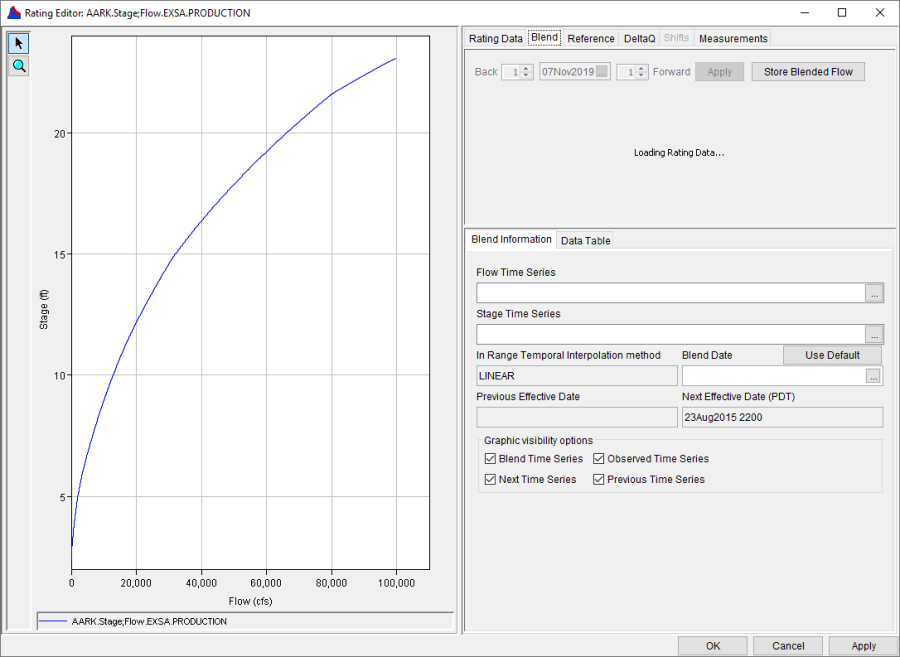
Reference Tab
The Reference Tab allows the addition of reference levels and reference ratings on the plot of the rating curve. These reference levels and reference ratings can be kept visible when switching across different tabs.
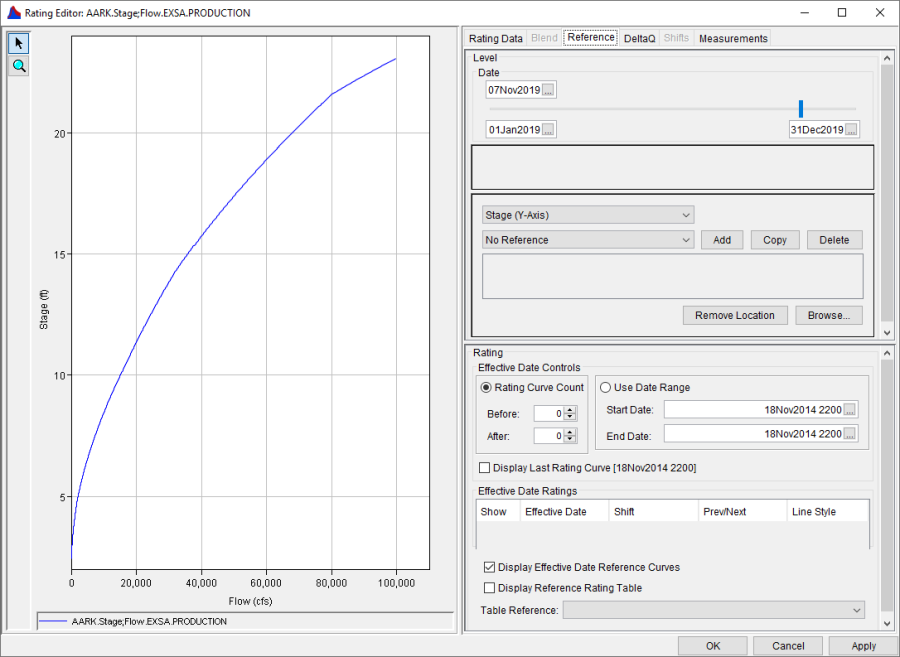
Reference Levels - streams and reservoirs have specified levels that are used as reference for water management. Some of the common specified levels are: Top of Inactive, Top of Conservation, or Top of Flood for reservoirs; and Flood Stage or Control Flow for streams. From the Reference Tab, you have various methods for selecting and viewing reference levels for a location.
Reference Ratings – a rating curve is identified by its effective date. The CWMS Rating Editor Window will only display one of these rating curves at a time. Reference ratings provide you with the option to display the other ratings curves by manipulating the effective date for each rating curve.
DeltaQ Tab
The DeltaQ Tab is only available for stream ratings. From the DeltaQ Tab, you can utilize the rating curve to generate an expanded table across a controlled range of values. Stage, Flow, DeltaQ, and Delta2Q are tabulated in the main table.
DeltaQ represents the change in flow from the previous stage entry, or the slope of the rating curve. Delta2Q, the rate of change of the slope, is calculated as the difference between the current and previous DeltaQ values divided by the current DeltaQ value. These parameters show how much flow increases at each state increment (DeltaQ) and how that increase is changing at each flow increment (Delta2Q). The values for the DeltaQ and Delta2Q shows whether the flow is increasing or decreasing. For channel flow, Delta2Q would be largest for the flattest channel side slopes and it would be zero for vertical side slopes. The table display of DeltaQ and Delta2Q can be switched on and off by checking or unchecking the Delta Q and Delta ˄2Q options.
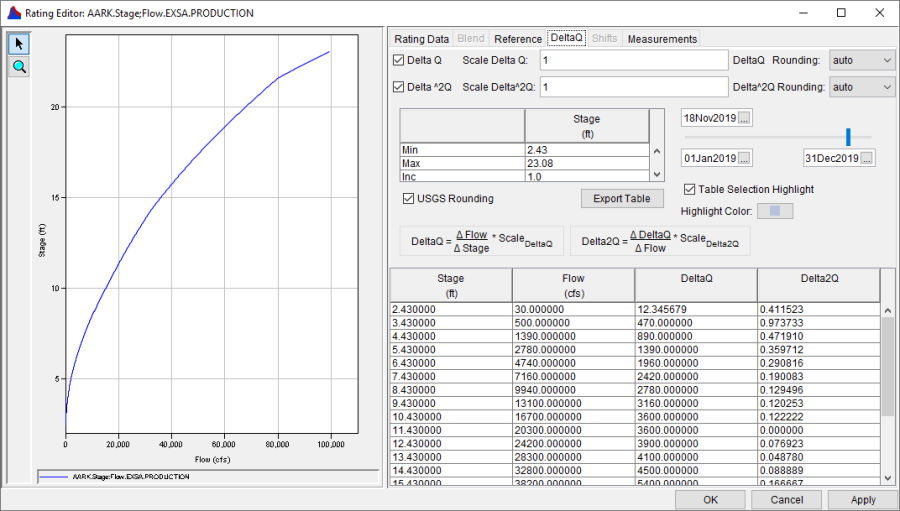
Expanded Tab
The Expanded Tab is displayed for rating curves other than stream ratings. Like the DeltaQ Tab, the Expanded Tab utilizes the rating to generate an expanded table across a controlled range of values. This tab is useful for a quick rating lookup, but this table is not editable. Unlike the DeltaQ Tab, the Expanded Tab only lists columns for all the independent and dependent parameters of the selected rating curve.
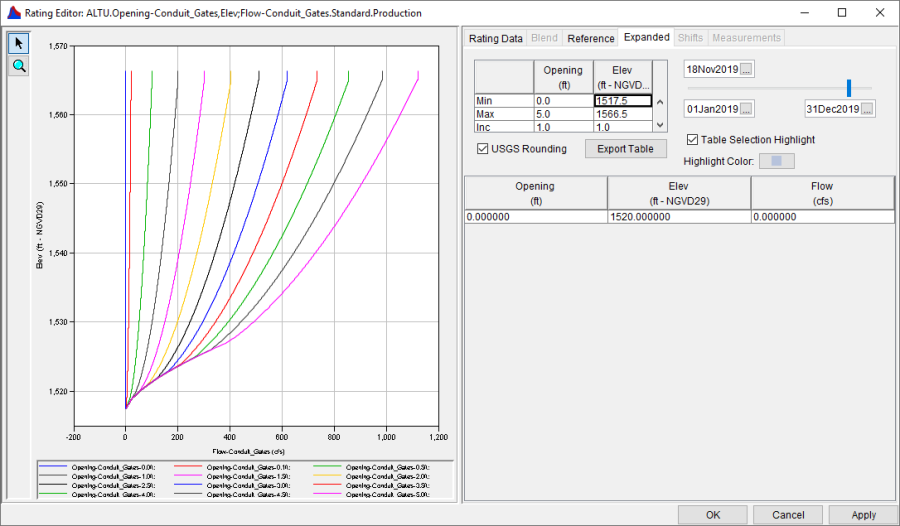
Shifts Tab
The Shifts Tab is available only for USGS Stream Ratings. From the Shifts Tab, shift data for the selected rating curve may be viewed, entered, and edited.
Shifts are gage-height adjustments applied to a rating curve without generating a new base curve. Shifts applied to the base curve create a shifted curve, which has all of the basic characteristics of a rating curve. Shifted curves have the same independent and dependent variables and shape of the base rating curve.
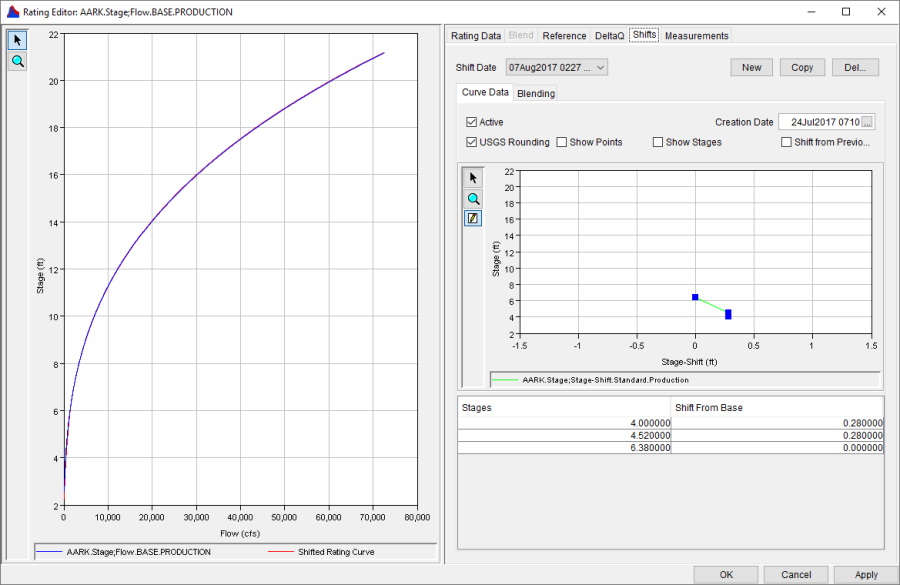
Measurements Tab
The Measurements Tab allows the viewing and editing of existing measurement data for a stream rating, and the capability to add new measurement data. The Measurements Tab is only available for stream ratings.
To maintain and verify the accuracy of the stage and flow data collected from stream gages, measurement data must be collected, studied, and verified periodically. Changes to a stream channel may affect the accuracy of the established rating curve for a stream gage location. The measurement data collected is used to update, revise and refine the rating for a stream gage location.
